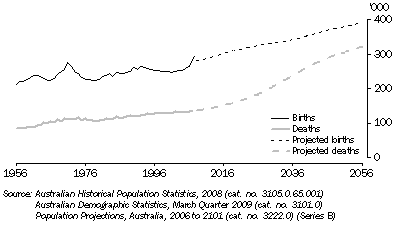BIRTHS AS A COMPONENT OF POPULATION GROWTH
Births form an important component of population growth. In 2008 there were 296,600 births in Australia. This is roughly twice the number of deaths (143,900), resulting in natural increase of around 152,700 people. Since 1976 Australian fertility has been below replacement level of 2.1 babies per woman; that is, below the number of births required to replace a woman and her partner. On current fertility rates, each woman can expect, on average, to have 1.97 babies over her lifetime. Despite this, natural increase is still positive because of the relatively young age structure of Australia's population. Although the number of births per woman is low, there are enough women currently in childbearing ages to keep the total number of births relatively high. Conversely, there are relatively few people at older ages, resulting in a relatively low number of deaths per year. As the population ages, the difference between numbers of births and deaths will decrease. Based on Series B of the most recent ABS population projections (Population Projections, Australia, 2006 to 2101, cat. no. 3222.0), the number of births is projected to remain higher than the number of deaths until 2101.
2.16 Components of population change(a) |
|  |
 | Births(b) | Deaths(b) | Natural increase | Net overseas migration | Population at end of period | Population increase(c) |  |
 | '000 | '000 | '000 | '000 | '000 | '000 | % |  |
|  |
| 1988 | 246.2 | 119.9 | 126.3 | 172.8 | 16 687.1 | 292.4 | 1.8 |  |
| 1989 | 250.9 | 124.2 | 126.6 | 129.5 | 16 936.7 | 249.6 | 1.5 |  |
| 1990 | 262.6 | 120.1 | 142.6 | 97.1 | 17 169.8 | 233.0 | 1.4 |  |
| 1991 | 259.1 | 119.7 | 139.4 | 81.7 | 17 387.0 | 217.3 | 1.3 |  |
| 1992 | 262.1 | 122.9 | 139.2 | 51.4 | 17 581.3 | 194.3 | 1.1 |  |
| 1993 | 258.6 | 120.8 | 137.8 | 34.8 | 17 760.0 | 178.7 | 1.0 |  |
| 1994 | 258.4 | 127.0 | 131.4 | 55.5 | 17 951.5 | 191.5 | 1.1 |  |
| 1995 | 254.9 | 125.1 | 129.8 | 106.9 | 18 196.1 | 244.6 | 1.4 |  |
| 1996 | 252.9 | 128.2 | 124.7 | 97.4 | 18 420.3 | 224.3 | 1.2 |  |
| 1997 | 251.1 | 128.8 | 122.3 | 72.4 | 18 609.1 | 188.8 | 1.0 |  |
| 1998 | 248.3 | 127.4 | 120.8 | 88.8 | 18 814.3 | 205.2 | 1.1 |  |
| 1999 | 250.2 | 128.2 | 122.0 | 104.2 | 19 038.3 | 224.1 | 1.2 |  |
| 2000 | 249.2 | 128.8 | 120.4 | 111.4 | 19 272.6 | 234.3 | 1.2 |  |
| 2001 | 246.0 | 128.8 | 117.1 | 136.1 | 19 534.0 | 261.3 | 1.4 |  |
| 2002 | 247.7 | 133.0 | 114.7 | 110.5 | 19 771.0 | 237.0 | 1.2 |  |
| 2003 | 248.0 | 131.8 | 116.2 | 110.1 | 20 011.9 | 240.9 | 1.2 |  |
| 2004 | 248.6 | 132.4 | 116.2 | 106.4 | 20 252.1 | 240.3 | 1.2 |  |
| 2005 | 263.4 | 131.4 | 132.0 | 137.0 | 20 544.1 | 291.9 | 1.4 |  |
| 2006 | r268.5 | r134.5 | r134.0 | r182.2 | r20 873.7 | r329.6 | r1.6 |  |
| 2007 | r287.0 | r138.9 | r148.1 | r216.2 | r21 237.9 | r364.2 | r1.7 |  |
| 2008 | p296.6 | p143.9 | p152.7 | p253.4 | p21 644.0 | p406.1 | p1.9 |  |
|  |
| p preliminary figure or series subject to revision |
| (a) Calendar year. |
| (b) For 2006 and earlier years, births and deaths in this table are based on year of occurrence, for population estimation purposes. For 2007, a combination of data based on quarter of occurrence (for the March and June quarters) and quarter of registration (for the September and December quarters) is used. Data for 2008 are based on year of registration. Numbers of births in this table will therefore differ from data elsewhere in this publication. |
| (c) Population increase will not necessarily equal the sum of natural increase and net overseas migration due to intercensal discrepancy. See Glossary for more information. |
2.17 Actual and projected births and deaths - Year ended 30 June

 Print Page
Print Page
 Print All
Print All
 Print Page
Print Page
 Print All
Print All